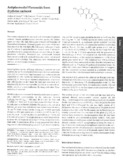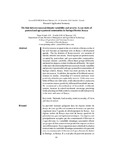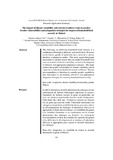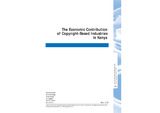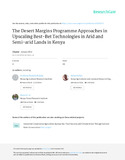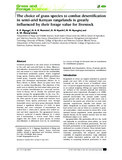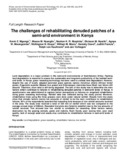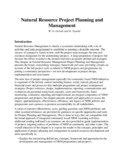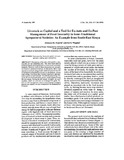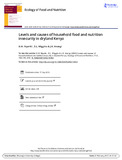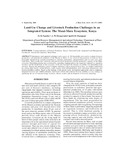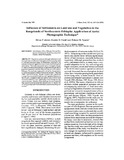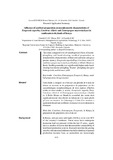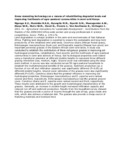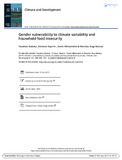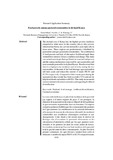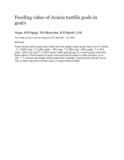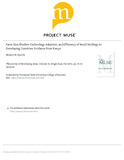Journal Articles: Recent submissions
Now showing items 861-880 of 1000
-
Interrogating alkyl and arylalkylpolyamino (bis)urea and (bis)thiourea isosteres as potent antimalarial chemotypes against multiple lifecycle forms of Plasmodium falciparum parasites.
(2015)Abstract A new series of potent potent aryl/alkylated (bis)urea- and (bis)thiourea polyamine analogues were synthesized and evaluated in vitro for their antiplasmodial activity. Altering the carbon backbone and terminal ... -
Antiplasmodial flavonoids from Erythrina sacleuxii.
(2005)Abstract The acetone extracts of the root bark and stem bark of Erythrina sacleuxii showed antiplasmodial activities against the chloroquine-sensitive (D6) and chloroquine-resistant (W2) strains of Plasmodium falciparum. ... -
Antiplasmodial activity, in vivo pharmacokinetics and anti-malarial efficacy evaluation of hydroxypyridinone..
(2015)Background: During the erythrocytic stage in humans, malaria parasites digest haemoglobin of the host cell, and the toxic haem moiety crystallizes into haemozoin. Chloroquine acts by forming toxic complexes with haem ... -
The link between seasonal climatic variability and poverty: A case study of pastoral and agro-pastoral communities in Baringo District, Kenya
(2010)Poverty remains rampant in the dry districts of Kenya so that it has now become an important item on Kenya’s development agenda. The dry districts of Kenya receive low amounts of rainfall, which is also erratic. These ... -
The impact of climate variability and extreme weather events on gender: Gender vulnerabilities and adaptation strategies for improved household food security in Malawi
(2009)The challenge to achieving household food security is a combination of biological, physical, and social factors. However, social factors, gender in particular, have received a cursory attention in adaptation studies. ... -
The Economic Contribution of Copyright-Based Industries in Kenya
(2009)The overall objective of the Kenyan study was to quantify the economic contribution of copyright and related rights-based industries in the country by estimating their value-added to GDP, share of national employment, and ... -
The Desert Margins Programme Approaches in Upscaling Best-Bet Technologies in Arid and Semi-arid Lands in Kenya
(2011)Kenya’s land surface is primarily arid and AQ1 semi-aridlands(ASALs)whichaccountfor84%ofthe totallandarea.TheDesertMarginsProgramme(DMP) inKenyahasmadesomecontributiontounderstanding which technology options have potential ... -
The choice of grass species to combat desertification in semi-arid Kenyan rangelands is greatly influenced by their forage value for livestock
(2013)Livestock production is the main source of livelihood in the arid and semi-arid lands in Africa. However, desertification characterized by vegetation degradation and soil erosion is a major threat to the sustainability of ... -
The challenges of rehabilitating denuded patches of a semi-arid environment in Kenya
(2010)Land degradation is a major problem in the semi-arid environments of Sub-Saharan Africa. Fighting land degradation is essential to ensure the sustainable and long-term productivity of the habited semiarid lands. In Kenya, ... -
Livestock as Capital and a Tao I for Ex-Ante and Ex-Post Management of Food Insecurity in Semi-traditional agro-pastoral societies:an example from South East Kenya
(1999)Discussions of the roles of livestock in many societies is not something new. They have been done in anthropological, sociological and, to some extent, economic literature. However, most of these discussions are normally ... -
Levels and causes of household food and nutrition insecurity in dryland Kenya
(2002)Ensuring food and nutrition security in the drylands of sub-Saharan Africa is a critical challenge. Often, information on the level of insecurity is either scanty or unavailable. This paper looks at food and nutrition ... -
Land-Use Change and Livestock Production Challenges in an Integrated System: The Masai-Mara Ecosystem, Kenya
(2009)Participatory rural appraisal techniques and a survey of 100 households were used to evaluate livestock production, and pastoral development of the Maasai in Mara. It was observed that patterns of land-use have principally ... -
Influence of Settlements on Land use and Vegetation in the Rangelands of Northeastern Ethiopia: Application of Aerial Photographic Technique
(1999)Population pressure through settlements and encroachment of cultivation into pastoral prime grazing lands in and semi-and areas of Africa have resulted in the reduction of natural vegetation cover, in turn transforming ... -
Influence of seed bed preparation on morphometric characteristics of Eragrostis superba, Cenchrus ciliaris and Enteropogon macrostachyus in southeastern drylands of Kenya
(2010)This study compared over a 6-month period effects of tractorploughing and hand-clearing seedbed preparation on morphometric characteristics of three arid and semi-arid grass species, namely; Eragrostis superba Peyr, Cenchrus ... -
Grass reseeding technology as a means of rehabilitating degraded lands and improving livelihoods of agro-pastoral communities in semi-arid Kenya
(2011)Land degradation is a major problem in the semi-arid environments of Sub-Saharan Africa. Fighting land degradation is essential to ensure the sustainable and long-term productivity of the inhabited semi-arid lands. Cenchrus ... -
Gender vulnerability to climate variability and household food insecurity
(2011)Climate variability presents different challenges for men and for women in their efforts to ensure household food security. However, despitetheircentralrole, genderissueshavereceivedonly cursoryattentioninadaptation ... -
Food poverty among pastoral communities in dryland Kenya
(2012)The dryland area of Kenya has the highest poverty incidence compared to other areas in the country; this is why poverty reduction has been a key government policy goal especially in these areas. These regions are predominantly ... -
Feeding value of Acacia tortilis pods in goats
(2003)Fresh Acacia tortilis pods were mixed with low quality native grass hay to form 5 rations - T 1 (100% hay), T 2 (25% pods + 75% hay), T 3 (50% hay + 50% pods), T 4 (75% pods + 25% hay) and T 3 (100% pods). Male goat groups ... -
Farm Size, Modern Technology Adoption, and Efficiency of Small Holdings in Developing Countries: Evidence from Kenya
(2011)Low efficiency is a problem in most developing agriculture, and is one of the reasons for food insecurity. This paper provides information on smallholder production efficiency in one of the developing Sub-Saharan Countries: ...


